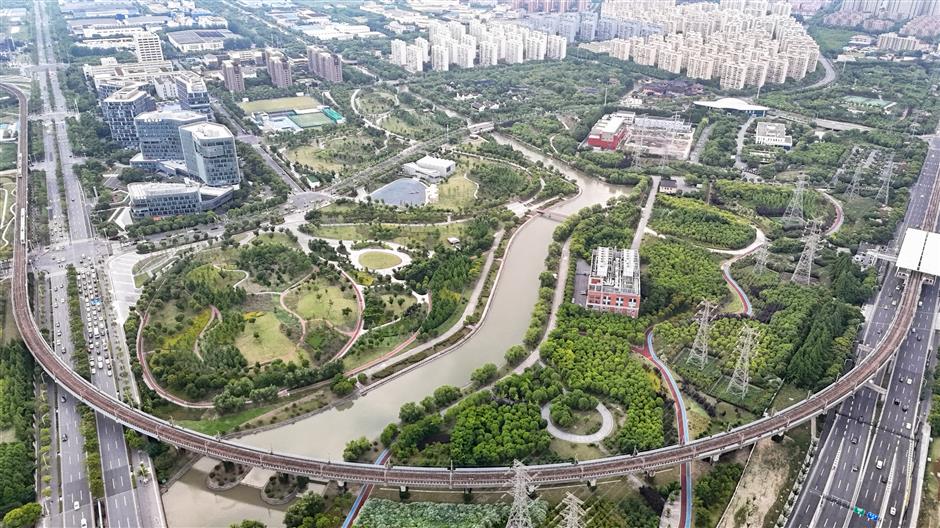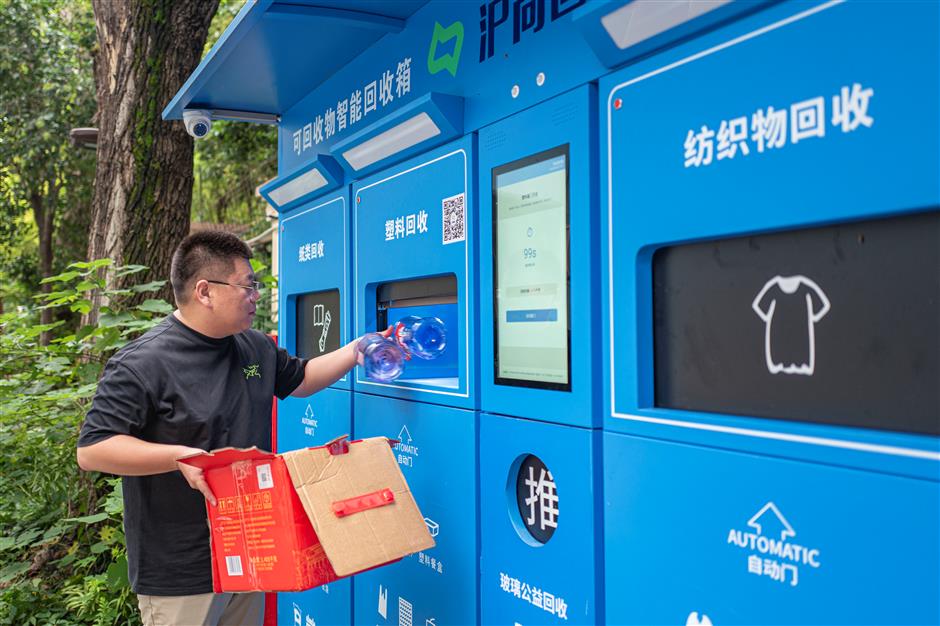

A cycad, pitcher plant, and floss silk tree inside the Shanghai Greenhouse at Expo Culture Park
Step into the Shanghai Greenhouse and you step onto another planet.
Under the vast glass dome, towering rainforest trees stand beside giant desert cacti, while orchids bloom and cycads – the so-called 'living fossils' – quietly endure.
It's a miniature planet where more than 3,000 species thrive, sustained not by energy-hungry machinery but by smart design: water basins with solar panels that cool the greenhouse and generate power, single-glazed walls that reduce heat loss, and irrigation systems that deliver water exactly where needed.
The result: this "mini Earth" produces about 60 percent of its own power.

Senlan Greenbelt, one of Shanghai's 10 major wedge-shaped green spaces, is seen in the picture.
The greenhouse is not just a spectacle. It's a glimpse of Shanghai's bigger ambition: to become a "park city."
The concept is not about scattering more greenery, but about weaving nature into everyday urban life.
"A true park city is one where people can live, work, commute, and relax within nature itself," wrote Li Jinlu, chief engineer at the China Urban Construction Design & Research Institute.
Shanghai's blueprint has a poetic shorthand: One river, one creek, one greenbelt park system.
The Huangpu River and Suzhou Creek act as blue arteries linking waterfront parks and green spaces. Around the city's outer edge, a broad greenbelt connects downtown parks with ecological buffer zones beyond, linking the city to the five new towns and forming a continuous green loop.
And it's not just an expert's plan. "In building a park city, we are working to expand citizen participation into every aspect, ensuring it is truly all-encompassing," said Zhang Yingping, director of the city's Public Green Space Construction Affairs Center.

A resident sorts waste in Shanghai's downtown Changning District.
If the park city is about space, waste sorting is about lifestyle.
In July 2019, Shanghai became the first Chinese city to mandate garbage classification. Six years later, the system has become an integral part of daily life.
In Hongkou District's Jiaxing Road neighborhood, residents sort their waste at smart recycling bins, 24-hour collection points, or through door-to-door pickup. Together, the community recycles nearly 700 tons of waste each month.
"Garbage sorting is not just about environmental protection, it's about a lifestyle change," said volunteer Hua Lei. "More and more residents now see recycling, reuse, and green travel as part of their everyday routine."
At the city's edge, the Laogang facility takes over. Once a sprawling landfill, it is now a "resource factory."
In 2024, it processed over six million tons of waste – the weight of seven Shanghai Towers – turning it into electricity, biogas, and construction materials. It now generates 1.5 billion kilowatt-hours annually, enough for more than 400,000 households.
"Our goal is to transform Laogang from a landfill into a green ecological park," said Wu Yuefeng, deputy general manager of Shanghai Chengtou's Laogang Base. A 21-kilometer jogging trail is even on the drawing board.

A bird soars above the Chongming Dongtan Nature Reserve in Shanghai.
The next frontier is economic: how to make ecology itself productive.
"The challenge is that ecological products are often hard to measure, hard to trade, hard to use as collateral, and hard to cash in," said Zhu Jun, director of the Ecology Division at Fudan University's Urban Planning Institute. "Shanghai needs new pathways to turn these values into real market products."
Zhu highlighted three key areas: the unique ecosystems of the estuaries and coastlines, the green spaces in the city center, and the revitalization of rural regions within Shanghai's global context.
"For example," he explained, "the Chongming Dongtan wetlands play a crucial role in protecting biodiversity. In rural areas, eco-agriculture not only benefits the environment but also helps improve farmers' livelihoods."
Finance is beginning to play its part. In 2024, the city launched a Green Finance Service Platform, with 170 projects already in its pipeline and more than 17.1 billion yuan (US$2.4 billion) in financing pledged, according to Securities Times.
From the greenhouse "mini Earth," to the waste relay between neighborhoods and Laogang, to the early experiments in eco-finance, Shanghai's green transition is no slogan. It is unfolding across space, lifestyle, and economy.
As Qiu Wenjin, deputy director of the Shanghai Development and Reform Commission, put it at the city's National Ecology Day event: "Green and low-carbon transition is the trend of the times. It brings great opportunities but also real challenges. Achieving it will take the effort of the whole society."

